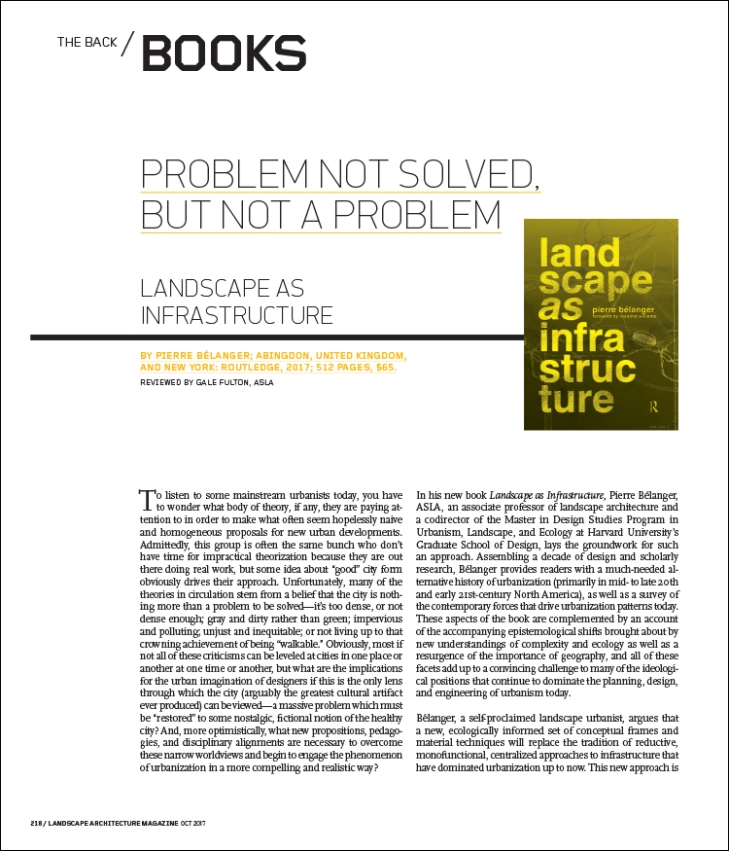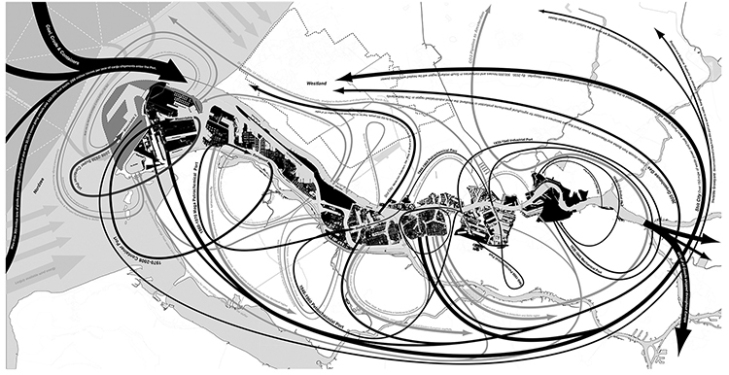REVIEWED BY GALE FULTON, ASLA
 FROM THE OCTOBER 2017 ISSUE OF LANDSCAPE ARCHITECTURE MAGAZINE.
FROM THE OCTOBER 2017 ISSUE OF LANDSCAPE ARCHITECTURE MAGAZINE.
To listen to some mainstream urbanists today, you have to wonder what body of theory, if any, they are paying attention to in order to make what often seem hopelessly naive and homogeneous proposals for new urban developments. Admittedly, this group is often the same bunch who don’t have time for impractical theorization because they are out there doing real work, but some idea about “good” city form obviously drives their approach. Unfortunately, many of the theories in circulation stem from a belief that the city is nothing more than a problem to be solved—it’s too dense, or not dense enough; gray and dirty rather than green; impervious and polluting; unjust and inequitable; or not living up to that crowning achievement of being “walkable.” Obviously, most if not all of these criticisms can be leveled at cities in one place or another at one time or another, but what are the implications for the urban imagination of designers if this is the only lens through which the city (arguably the greatest cultural artifact ever produced) can be viewed—a massive problem which must be “restored” to some nostalgic, fictional notion of the healthy city? And, more optimistically, what new propositions, pedagogies, and disciplinary alignments are necessary to overcome these narrow worldviews and begin to engage the phenomenon of urbanization in a more compelling and realistic way?
In his new book Landscape as Infrastructure, Pierre Bélanger, ASLA, an associate professor of landscape architecture and a codirector of the Master in Design Studies Program in Urbanism, Landscape, and Ecology at Harvard University’s Graduate School of Design, lays the groundwork for such an approach. Assembling a decade of design and scholarly research, Bélanger provides readers with a much-needed alternative history of urbanization (primarily in mid- to late 20th and early 21st-century North America), as well as a survey of the contemporary forces that drive urbanization patterns today. These aspects of the book are complemented by an account of the accompanying epistemological shifts brought about by new understandings of complexity and ecology as well as a resurgence of the importance of geography, and all of these facets add up to a convincing challenge to many of the ideological positions that continue to dominate the planning, design, and engineering of urbanism today.
Bélanger, a self-proclaimed landscape urbanist, argues that a new, ecologically informed set of conceptual frames and material techniques will replace the tradition of reductive, monofunctional, centralized approaches to infrastructure that have dominated urbanization up to now. This new approach is imperative if the design, planning, and engineering disciplines are to engage productively the dynamic forces of the 21st century such as shifting climates, migrating populations (both human and nonhuman, one assumes), and the endless cycling of materials across the planet. Bélanger, who is critical of the ideology of city design premised upon “centralization, containment, and compactness,” calls for an alternative to the nostalgic inheritance of “Old World” city and landscape making that is more in line with the postindustrial realities of contemporary urbanization. Such a shift requires the abductive capacity of the designer to replace the inductive and deductive approaches of engineering and planning. “Abduction draws from many fields and appropriates many levels of knowledge, extensively and intensively, to formulate ideas and strategies based on uncertain conditions, indeterminate circumstances, and sometimes incomplete information.” But Bélanger is realistic about the fact that, even though landscape architects and designers may be particularly well suited to engage this project given the ways they are educated, a cross-disciplinary alignment of landscape architecture, civil engineering, and urban planning is required to undertake the “strategic design of infrastructural and territorial ecologies” as a “synthetic landscape of living, biophysical, and sociopolitical systems that operate as urban infrastructures to shape the future of urban economies and cultures into the twenty-first century.”

Graphic timelines such as this one showing the evolution of the agronomic landscape demonstrate the synthetic capacity of designers to embrace complexity rather than suppress it. Image courtesy of Opsys/Curtis Roth.
Landscape as Infrastructure is a 500-plus-page slab of a book that combines old and new writings by Bélanger along with a variety of explanatory photos, graphic timelines, and diagrams of dynamic processes of urbanization. The book begins with 10 “prepositions” that set up the essays that follow and provide a more exhaustive case for their validity and potential as strategic catalysts. Prepositions include “The fundamental problem with urbanization is that we consider it a problem,” “Decentralization is one of the greatest structural forces reshaping patterns of urbanization,” and “Ecologies of scale are the new post-industrial economies for the weak world of the future.”
This introductory section is followed by 10 essays that correspond to the 10 prepositions and serves to juxtapose “conditions and dynamics in and out of the industrialized West…” across “…a series of scales, strategies, and systems for understanding and shaping knowledge of urbanization through contemporary patterns, processes, and precedents.” Bélanger is at his best in chapters such as “Systems of Systems,” which provides a rigorously researched and referenced alternative history of urbanization that challenges, refutes, or adds nuance to the more traditional history of urbanization and infrastructure in North America. Informed by the work of regional urbanists such as Benton MacKaye, Jean Gottmann, and Howard T. Odum, Bélanger argues that by replacing the predominant urbanization-as-problem lens with an “ecological optic,” a new generation of landscape infrastructuralists could move beyond the need to “minimize, control, or arrest” the processes of urbanization to shape and direct these forces toward more productive socioeconomic and socioecological ends.
In a chapter on “Ecologies of Disassembly,” Bélanger describes how a shift to a postindustrial economy is accompanied by the emergence of “waste ecologies” in which materials that previously held little or no value are now “catalyzing the birth of novel ecologies across major urban agglomerations…and across different continents, where the significance of circular economies make growth possible beyond production.” Bélanger then goes on to describe these ecologies in places such as the quasi-informal markets of Lagos, Nigeria, and the demanufacturing of “white trash” in Japan, to name only two of several examples. The author sees such “multilateral feedback strategies” as diversion, separation, recycling, and composting as increasingly common globally and a necessary development in the shift to more ecological forms of postindustrial urbanization.

Mapping the complex flows of materials over time is essential to engaging the city as an open system. Image courtesy of Opsys.
In addition to the aforementioned chapters on systems and wastes, chapters on “Regionalization,” “Synthetic Surfaces,” and “Infrastructural Ecologies” support a multiscalar and multilayered understanding of the patterns and processes of contemporary urbanization. What is perhaps less explicit is how landscape as infrastructure is actually defined or practiced, but I think this is in part owing to the expectation that infrastructure will continue to operate as it has in the past under the logic of closed systems rather than as diffuse, decentralized componentry of a much larger ecology. This is arguably the most significant takeaway for a discipline such as landscape architecture that continues to privilege projects that some would call high design and which are often characterized by their discrete site boundaries, exquisite materiality and detailing, and preferably ample budgets. Although that is not to say that such landscapes are necessarily incompatible with landscape as infrastructure, the latter type requires a different “optic” through which to evaluate and value them and to take into consideration characteristics and qualities of new landscapes that engage the ubiquity of logistics, that embrace the aesthetic qualities of time and change that are so much a part of dynamic ecologies (whether organic or inorganic), and that develop the potentials inherent in decentralization.
Landscape as Infrastructure is a compelling addition to a growing body of literature that challenges simplistic notions about the city, or more accurately, urbanization. The book is critical of architecture’s overreliance on “theory,” and civil engineering’s near-total lack of it; of the overreliance by urban planning (whether practiced by architects, urban designers, or landscape architects) on outmoded or unrealistic theories and practices (the “streets, blocks, and buildings” approach); and of the “borrowed, aristocratic histories of the profession of landscape architecture from the Old World and its surrogate, intellectual affiliations with the discipline of architecture….” And given the fact that engineers outnumber architects, landscape architects, and urban planners by more than five to one, and that an often uncritical belief in density and centralization dominates the imagination of many, if not most, professional designers and planners, as well as many academics training the future professionals who might shape urbanization, it may appear that what’s ahead is simply more of the same. But despite what may at times seem to be the daunting inertia of landscape and urbanism—especially in North America—I would argue that there is much to be optimistic about as well, given the innovative new landscape architecture firms now experimenting with a variety of landscape infrastructures and new generations of academics that are finding creative ways to educate across a spectrum of practices from high design to landscape as infrastructure. Landscape as Infrastructure provides a new optic through which to see advances along these lines that are already here but not fully understood, as well as a new foundation from which to bring others into being.
Landscape as Infrastructure by Pierre Bélanger; Abingdon, United Kingdom, and New York: Routledge, 2017; 512 pages, $65.
Gale Fulton, ASLA, is director of the School of Landscape Architecture at the University of Tennessee and can be contacted at gfulton@utk.edu or followed on Twitter @landintel.


